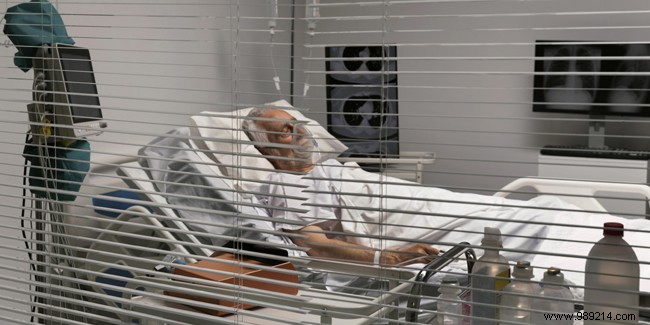
A pressure ulcer refers to a more or less significant wound on the skin that does not heal on its own. It appears when the skin is not sufficiently irrigated by blood. A common situation, especially among the elderly who are forced to stay in bed due to poor health, who have blood circulation problems, or even an illness such as diabetes.
We speak of bedsores to designate a wound which can be more or less deep and which does not heal spontaneously. The pressure sore is recognizable by the presence of a crust on the skin of a color that draws towards black, in particular when it is not treated from the beginning of its appearance, which forms due to necrosis of the tissues, that is to say the deterioration of the skin, even the death of its cells. Because the pressure ulcer does not only affect the surface of the skin, but also the tissues below it.
At the very beginning of its appearance, the pressure sore, localized on areas of support of the body and most often in places characterized by protuberances of the bones, takes the form of red spots. Then these become blue in color and take on a scratched appearance. The eschar then turns into a wound that can even become infected and ooze.
A pressure sore forms when the surface of the affected skin is not sufficiently irrigated by blood. This lack of blood circulation may be due to prolonged compression of the part of the body concerned, in particular when the skin is trapped, because of this compression, between the part of a bone located very close to the surface of the skin and too firm support. The pressure exerted prevents the blood from circulating normally at the level of the skin and the tissues which are placed just below, with the consequence of asphyxiation of the area thus compressed.
This is why the elderly, forced to be bedridden for health reasons, are often affected by pressure sore problems, particularly because they are lying on mattresses that are too hard.
People who have mobility problems, for example who are in a wheelchair much of the time, are also more prone to pressure sores. In fact, the latter affect more certain parts of the body such as the heels and the sacrum. It is estimated that between 20% and 50% of people over the age of 65 hospitalized are affected by pressure sores that are related to immobility or prolonged sitting or lying down.
Seniors are also more at risk of getting pressure sores because their skin becomes thinner and more fragile as they age. As a result, the elderly are more likely to experience local blood supply problems. On the other hand, undernutrition, also often observed in older people, increases the risk of developing pressure sores.
The pressure sore can also be linked to health problems such as arterial or venous circulation disorders. In the latter case, we speak more of an ulcer than a pressure sore.
A pressure sore can appear because of a disease that causes poor blood circulation, such as diabetes.
Pressure ulcers greatly affect the lives of people who have them. First, because the presence of these more or less deep wounds is painful and, second, because they are difficult to treat. In addition, bedsores often expose you to complications that can be both local and general.
Locally, a pressure sore can, in fact, become more and more painful and especially become infected. It can cause reactions around the wound such as eczema, or even an infectious and contagious disease called erysipelas. Over time, pressure sores can also turn into cancerous lesions.
Pressure sores can also have consequences on the general state of health due to a generalized infection (sepsis), or even anemia. They can also affect the psychological state of the patient who, because of pressure sores, loses his autonomy and has a poor image of himself, especially since pressure sores are often linked to end-of-life conditions.
To treat a pressure sore as well as possible, it is first necessary to find the exact causes of its appearance, which is not always easy, and to reduce the pressure exerted on the skin in the places affected by these wounds.
Treating a pressure sore consists of relieving the pain it causes and providing local care with specific dressings adapted to the part of the skin that has this type of wound that does not heal on its own. These types of care, carried out on a regular basis by nurses, are most often complex.
Preventing the occurrence of pressure sores begins with screening for possible blood circulation disorders, risk factors for the appearance of pressure sores. This is why people with diabetes in particular should take special care of the areas of their body that are more likely to be affected by pressure sores and monitor their possible appearance.
In people who are permanently bedridden, it is important to avoid all pressure points as much as possible and to monitor the areas of the body concerned. The risk of bedsores can be limited, for example, by making sure that the person changes position every 2 or 3 hours, by adopting a suitable mattress and pillows, and if possible such equipment specially designed for patients with bedsores.
In general, the appearance of bedsores can also be prevented by maintaining good skin hygiene, as well as a balanced and sufficient diet for the bedridden person.